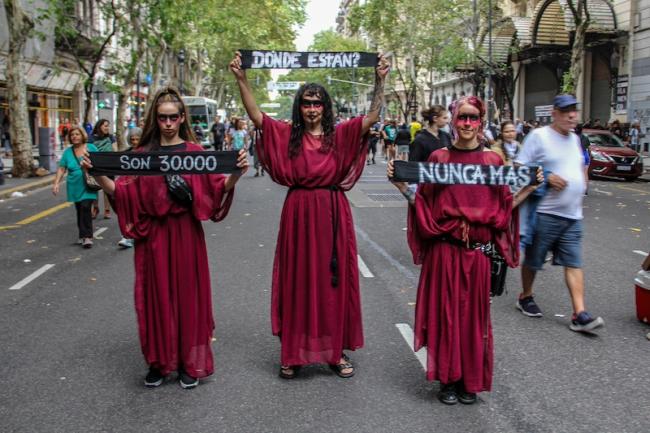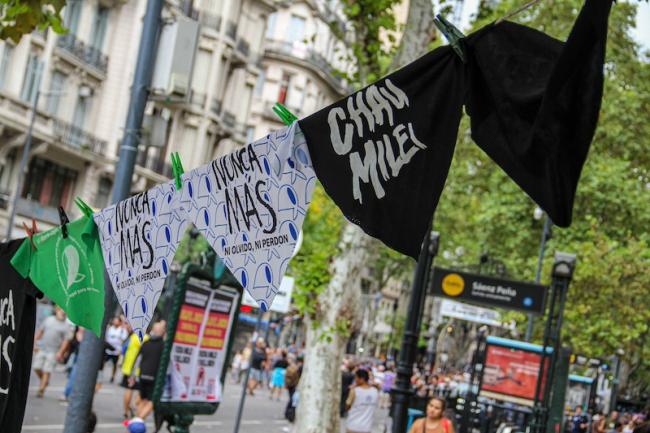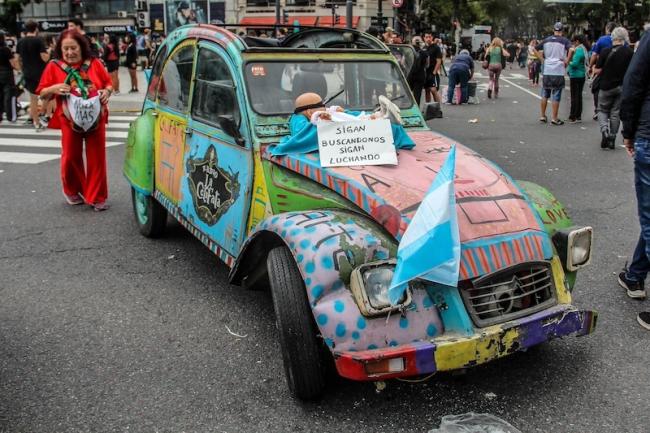
Walking around downtown Buenos Aires was very difficult. A monstrous crowd of people of all ages, with banners, costumes, and paintings, was trying to reach the Plaza de Mayo on the Day of Memory, Truth, and Justice. The sign at the head of the main march advanced from the National Congress towards the Casa Rosada, 10 blocks down, but there were so many demonstrators that the entire route was filled with movement and bodies throughout the afternoon.
On March 24, 1976, the Argentine armed forces took control of the national government with international support from neighboring countries, which were experiencing their own dictatorships, and from the United States under the framework of Plan Condor. The coup also had the domestic support of institutions such as the Catholic Church and a large part of Argentine society worn down by growing political violence and economic deterioration. The civilian-religous-military dictatorship was a culmination of all the de facto governments that interrupted the rule of law over the last century. The project instituted by the military junta was not only a systematized destruction of bodies and ideas, but also of the national economy and industry. Its failure was so resounding that it became clear that democracy had to be valued in order to be protected. That is why every March 24 is an opportunity to keep the memory of the genocide active and to instill values that reaffirm democracy.
Argentina is seen as a pioneer worldwide both for the trials that were held of those responsible for committing gross human rights violations in the context of the dictatorship, and for legislation that attempts to prevent further abuses and repair the damage done to the victims and relatives of those detained, tortured, and murdered. As Lily Galeano, an activist from the grassroots movement Nuestramérica says, “human rights in Argentina are a beacon for a very broad collective that began with relatives, mothers, grandmothers and sons, and that is why today we continue fighting. Thanks to this collective, trials have been carried out and continue throughout the country, despite having gone through [antagonistic] governments, this allows us to move forward with memory.”
Authoritarianism, brutality, and omnipresent terror were the main features of the seven-year dictatorship, almost the same period that a democratic government with reelection would last today. After the return to democracy in 1983, the reactionary right wing consisted of marginal social groups. However, the argument of those who tried to justify crimes against humanity were never completely eliminated. The so-called “theory of the two demons,” which equates state terrorism with the mobilizations of armed civilian groups, attempts to justify such actions. “Our elders were not kidnapped for fighting for memory, truth and justice,” said Sabrina Bolke, a family member of detainees tortured during the dictatorship and a victim of aggressions during the current government, “but for fighting for a liberated homeland, for the redistribution of wealth, for a country without poverty and exclusion, free from capitalist and neoliberal oppressions.”
The Reactionary Advance in Argentina
The panorama changed in 2015. For the first time in the history of Argentina, the reactionary right wing won democratic elections, gaining access to power through constitutional means. The great economic powers behind private companies and the mass media had campaigned for Mauricio Macri’s coalition. Furthermore, Macri’s administration left the largest debt that any country has held with the International Monery Fund (IMF), in addition to committing outrages that pushed the limits of what should be institutionally tolerated. The Macri government paved the way for the ascension of Javier Milei and his far-right party, La Libertad Avanza. The legacy of the last military dictatorship is present in most Argentine families as either victims or members of the Armed Forces. The living memory of state terror has long been a common topic in culture and politics, with youth at the vanguard of the defense of historical memory. But in recent years, young people have become conservative.
La libertad Avanza co-opted a very young, primarily male electorate who spent their adolescence in the pandemic, submerged in uncertainty and exposed to influencers who blamed all evils on the great transfeminist achievements of recent years. These sectors promote individualism, corporatism, and the rejection of public policies. The advance of neo-fascism in Argentina surprised those of us who believed that the defense of democracy was a solid value. In 2015, conservatism was still expressed in a veiled form. By 2023, electoral proposals were explicitly intolerant: the elimination of state protection of the most vulnerable and the repeal of laws achieved by minority groups.

“Today, as in the dictatorship, we see an authoritarian and repressive government. Then there were disappearances, kidnapping of pregnant women, appropriation of children, and the murder of 30,000 people,” says Galeano, who experienced firsthand the worst impacts of the dictatorship as the daughter of a worker who disappeared in 1976. “Today, the liberal government of Javier Milei reproduces that authoritarianism and repression, trying to erase our history and dismantle human rights policies.”
The dismantling of these policies occurred on two fronts: the elimination of budgets for memory and the validation of hate speech. Cases such as that of photojournalist Pablo Grillo, who was critically injured by a security agent on March 12 while documenting repression at a protest by retirees, or that of Bolke, who was attacked for being part of the memory group Hijos por la Identidad y la Justicia contra el Olvido y el Silencio (HIJOS, Children for Identity and Justice against Oblivion and Silence), evidence the escalation of violence and authoritarianism. “In my own house a man grabbed me from behind, covered my mouth and eyes, destroyed my things, my memories, while they insulted me and hit me against the wall and in the ribs,” says Bolke regarding an attack she suffered in March of last year as a result of her activism. Her assailants were clear about their motivations for breaking into her home and subjectig her to terrible humiliations: “They pointed guns at me, they told me they were not coming to steal but to kill me for getting involved in ‘the issue of human rights.’” When Bolke was left alone and able to call the police, they discovered that the attackers had left graffiti on the wall of her home with slogans characteristic of La Libertad Avanza.
Streets in Dispute: From Repression to Popular Mobilization
Stories of this gravity are becoming more and more common. The government, however, has reached an inflection point. Social discontent has become more and more visible and the administration must demonstrate strength in protecting one of its main bastions: free and orderly streets. It is true that a large part of the population had grown tired of constant roadblocks that prevented the free movement of citizens. Under the previous government, marches were a daily occurrence in major cities like Buenos Aires, Córdoba, and Rosario, and this method of protest resulted in the steady exhaustion of those who did not understand the slogans or the urgency of protest demands. Milei was able to see this conflict of interests, and from the beginning of his administration all popular demonstrations were violently repressed.
Those who have continued to gather in front of the National Congress without tiring are the elderly, the main victims of Milei’s brutal austerity program, who once again face cuts in pensions, medication allowances, and other measures taken to the detriment of their rights and wellbeing in order to protect the fiscal budget count. But as of late, images of the police and gendarmes savagely beating the elderly have not stopped being reproduced, and social tolerance has begun to break down.
24M Today
On Monday, March 24, massive mobilizations and slogans resounded in the streets, clubs, schools, and on every corner without fear of reprisals. “Memory moves us sentimentally because it speaks of what we live and feel, of identity, it is passion, pain, happiness, conviction, joys, losses and achievements,” says Bolke. “The 30,000 are memory, with their beliefs and their humanity.” The forcefulness of this year’s demonstrations reflected that the people still remember the terror of those seven years of dictatorship. Likewise, they show that Argentines do not forget that the victims of the dictatorship were tortured, disappeared, and murdered for dreaming of a more just world, for freely expressing their love or political preferences, for being proud of what made them different, for their tastes, their opinions—in short, for their own identity. Bolke gestures to the potency of this feeling of identity when she recalls being attacked: “when the attacker tied my mouth with a Racing Club [Argentine soccer club] shirt, I never felt so alone in my life. But I thought that, at least, I would die kissing the shirt of the club I love and that my family left me and that gives me identity, which is part of my memory.”

March 24 was a historic day in which the Argentine people took to the streets all over the country with slogans, chants, and demands that are typical of the date, such as references to the dictatorship, the call for a common jail for military members, and rejections of the denialism surrounding the genocide and the 30,000 disappeared. In addition, protesters used slogans that point to the current context, such as denouncing the new IMF agreement that is underway, Milei’s anti-rights agenda, or the fascist advance in Argentina and around the world. The document that was read by protesters outlining the demands and agreements of each political group that helped organize the demonstration embodied the seriousness of the events it evoked. But the day was also filled with artistic interventions, play areas for children, applause, smiles in the presence of the Mothers and Grandmothers of Plaza de Mayo, and a great deal of complicit emotion on the part of those in attendance.
They say that moments of crisis help to set priorities. After 19 years of marches and slogans divided by political differences, this 24M invoked a call of unity by the most important human rights organizations — el Encuentro de Memoria, Verdad y Justicia (the Meeting of Memory, Truth, and Justice) and the Mesa de Organismos de Derechos Humanos (the Table of Human Rights Organisms)—and the document presented this year was unique in that regard. Differences and discussions are necessary, but division only weakens progress. Beyond the setbacks and blows, the conviction that democracy is the only possible form of freedom continues to be the norm.
Virginia Tognola is a teacher, communicator, and independent writer. A militant of the popular camp in Argentina, her texts address issues of culture, politics, and human rights. She has published in journalistic media such as Nacla.org, New Internationalist, El Grito del Sur, and Progressive International. Her narrative has earned her awards, such as a special mention in the X Certamen SIERRA DE FRANCIA.

